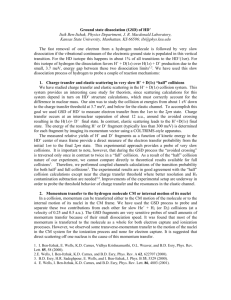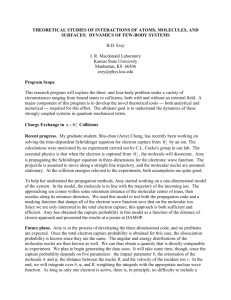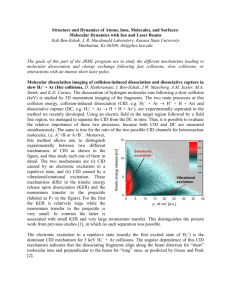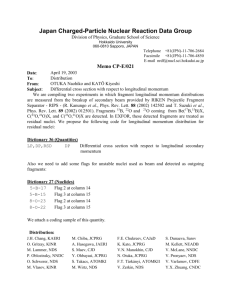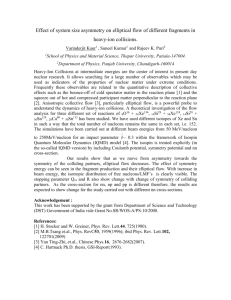Charge transfer and elastic scattering in very slow H+ + D(1s) “half
advertisement
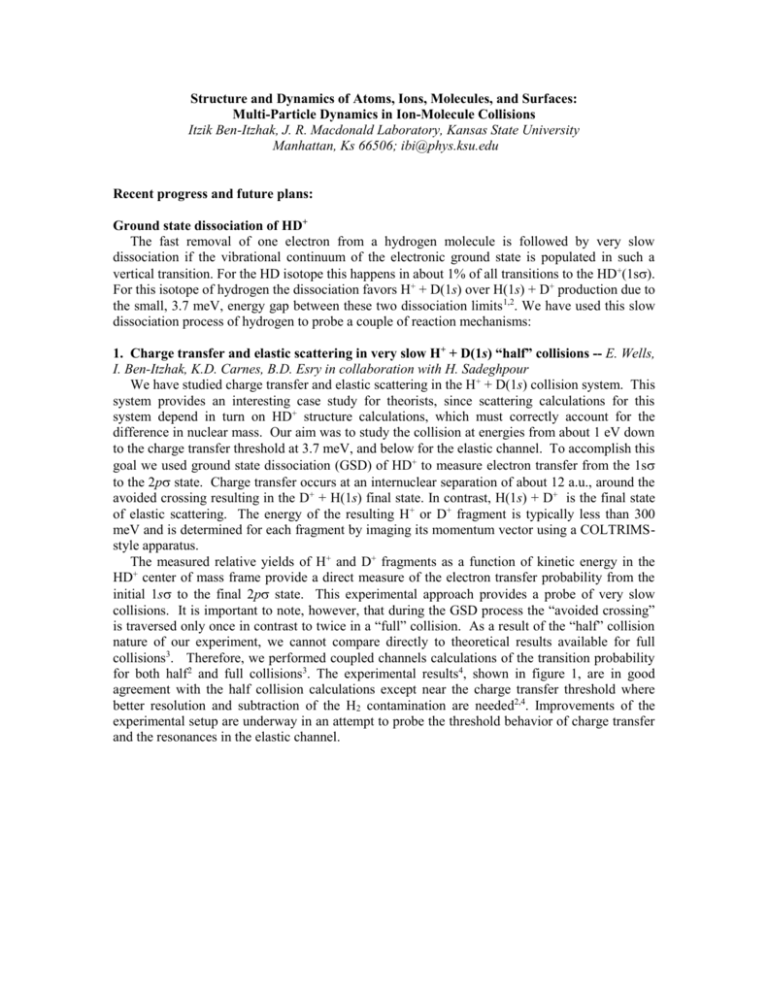
Structure and Dynamics of Atoms, Ions, Molecules, and Surfaces: Multi-Particle Dynamics in Ion-Molecule Collisions Itzik Ben-Itzhak, J. R. Macdonald Laboratory, Kansas State University Manhattan, Ks 66506; ibi@phys.ksu.edu Recent progress and future plans: Ground state dissociation of HD+ The fast removal of one electron from a hydrogen molecule is followed by very slow dissociation if the vibrational continuum of the electronic ground state is populated in such a vertical transition. For the HD isotope this happens in about 1% of all transitions to the HD+(1s). For this isotope of hydrogen the dissociation favors H+ + D(1s) over H(1s) + D+ production due to the small, 3.7 meV, energy gap between these two dissociation limits 1,2. We have used this slow dissociation process of hydrogen to probe a couple of reaction mechanisms: 1. Charge transfer and elastic scattering in very slow H+ + D(1s) “half” collisions -- E. Wells, I. Ben-Itzhak, K.D. Carnes, B.D. Esry in collaboration with H. Sadeghpour We have studied charge transfer and elastic scattering in the H+ + D(1s) collision system. This system provides an interesting case study for theorists, since scattering calculations for this system depend in turn on HD+ structure calculations, which must correctly account for the difference in nuclear mass. Our aim was to study the collision at energies from about 1 eV down to the charge transfer threshold at 3.7 meV, and below for the elastic channel. To accomplish this goal we used ground state dissociation (GSD) of HD+ to measure electron transfer from the 1s to the 2p state. Charge transfer occurs at an internuclear separation of about 12 a.u., around the avoided crossing resulting in the D+ + H(1s) final state. In contrast, H(1s) + D+ is the final state of elastic scattering. The energy of the resulting H+ or D+ fragment is typically less than 300 meV and is determined for each fragment by imaging its momentum vector using a COLTRIMSstyle apparatus. The measured relative yields of H+ and D+ fragments as a function of kinetic energy in the HD+ center of mass frame provide a direct measure of the electron transfer probability from the initial 1s to the final 2p state. This experimental approach provides a probe of very slow collisions. It is important to note, however, that during the GSD process the “avoided crossing” is traversed only once in contrast to twice in a “full” collision. As a result of the “half” collision nature of our experiment, we cannot compare directly to theoretical results available for full collisions3. Therefore, we performed coupled channels calculations of the transition probability for both half2 and full collisions3. The experimental results4, shown in figure 1, are in good agreement with the half collision calculations except near the charge transfer threshold where better resolution and subtraction of the H2 contamination are needed2,4. Improvements of the experimental setup are underway in an attempt to probe the threshold behavior of charge transfer and the resonances in the elastic channel. 0.6 Vpusher = 100 V Vpusher = 400 V Coupled Channels Calculations (l = 0) PTransfer(Ek) Pelastic(Ek) 0.8 0.4 0.4 Vpusher = 400 Volts Vpusher = 100 Volts Vpusher = 1000 Volts Vpusher = 3000 Volts Coupled channels calculation 0.2 0.0 0 10 20 30 Ek (meV) 40 50 60 0.0 0 50 100 150 200 250 300 350 Ek (meV) Figure 1: Right: Charge Transfer and Left: Elastic Scattering in H + + D(1s) “half” collision. 2. Separating the momentum transfer to a hydrogen molecule as a whole from the momentum transfer to the internal motion of its nuclei in the CM frame -- I. Ben-Itzhak, C.L. Cocke, M.A. Abdallah, M. Stöckli in collaboration with W. Wolff and H.E. Wolf In a collision momentum can be transferred either to the CM motion of the molecule or to the internal motion of its nuclei in the CM frame. We have used the GSD process to probe and separate these two contributions from each other for slow He+ + H2 (or D2) collisions (at a velocity of 0.25 and 0.5 a.u.). The GSD fragments are very sensitive probes of small amounts of momentum transfer because of their small dissociation speed. It was found that for these collisions most of the momentum is transferred to the molecule as a whole for both electron capture and ionization processes. However, we observed some transverse momentum transfer to the motion of the nuclei in the CM system for the ionization process and none for electron capture. It is suggested that direct scattering off one nucleus is the cause of this momentum transfer. 1. I. Ben-Itzhak, E. Wells, K.D. Carnes, Vidhya Krishnamurthi, O.L. Weaver, and B.D. Esry, “Symmetry breakdown in ground state dissociation of HD +”, Phys. Rev. Lett. 85, 58 (2000). 2. E. Wells, I. Ben-Itzhak, K.D. Carnes, and B.D. Esry, “Asymmetric branching ratio for the dissociation of HD+(1s)”, Phys. Rev. A 62, 622707 (2000); and references therein. 3. B.D. Esry, H.R. Sadeghpour, E. Wells, and I. Ben-Itzhak “Charge exchange in slow H+ + D(1s) collisions”, J. Phys. B 33, 5329 (2000); and references therein. 4. E. Wells, I. Ben-Itzhak, K.D. Carnes, and B.D. Esry, “Charge exchange and elastic scattering in very slow H+ + D(1s) “half” collisions”, Phys. Rev. Lett. 86, 4803 (2001). The high velocity limit of the double- to single-ionization ratio of hydrogen molecules -- I. Ben-Itzhak, E. Wells, D. Studanski, Vidhya Krishnamurthi, K.D. Carnes, in collaboration with H. Knudsen The ratio of double to single ionization of helium by fast-ion impact has been a topic of intensive research. There has been particular interest in the high-velocity limit, which is a measure of the importance of electron-electron mechanisms for ionization of the second electron1. In contrast, the same ratio for the hydrogen molecule has not been determined as accurately. We have measured this ratio for fast proton impact as a function of the proton velocity. Using electron-impact data2 and our measurements the high-velocity limit was determined to be 0.0018±0.0002 %. This ratio is about a factor of 1.4 smaller than the same ratio for the atomic helium target. Most of this difference between the atomic and molecular two-electron targets stems from the higher probability to ionize one electron in hydrogen than in helium, which in turn is due to the lower binding energy in hydrogen. It was shown that, for 1-12 MeV proton impact, the single ionization of hydrogen is about a factor of 1.8 larger than that of helium. In contrast, the double ionization of these two-electron targets is approximately the same. It is suggested that the stronger electron-electron interaction in the helium target caused by the smaller average distance between the target electrons compensates for the higher probability for ionizing the first electron in hydrogen. Whether or not this is actually the case requires a quantitative theoretical treatment to determine. 1. J. Ullrich, R. Moshammer, H. Berg, R. Mann, H. Tawara, R. Dörner, J. Euler, H. Schmidt-Böcking, S. Hagmann, C.L. Cocke, M. Unverzagt, S. Lencinas and V. Mergel, Phys. Rev. Lett. 71, 1697 (1993). 2. H. Kossmann, O. Schwarzkopf, and V. Schmidt, J. Phys. B 23, 301 (1990). 3. I. Ben-Itzhak, E. Wells, D. Studanski, Vidhya Krishnamurthi, K.D. Carnes, and H. Knudsen, “Double and single ionization of hydrogen molecules by fast proton impact”, J. Phys. B 34, 1143 (2001). Formation and decay mechanisms of doubly charged molecular ions -- I. Ben-Itzhak, Z. Chen, B.D. Esry, C.D. Lin, E.Y. Sidky. In collaboration with: A. Bar-David, J.P. Bouhnik, I. Gertner, B. Rosner, Z. Amitay, O. Heber, D. Zajfman, W. Koch, R. Röhse, W. Klopper The experimental mean lifetime of 3He4He2+ molecular ions (of about 300 ns) has been attributed to high angular momentum states. It has been suggested that the source of this angular momentum is the creation mechanism of the 3He4He+ parent molecular ions in the ion source. The suggestion that He2+ dimers are preferentially formed with high angular momentum is of great importance for those who are interested in ion chemistry. However, it is based on the assumption that the decay of the 3He4He2+ is by tunneling of the electronic ground state and that the potential energy curve is known precisely. To verify that the association of the measured lifetime with the tunneling of the ground state is correct we developed a new experimental method, which enables the simultaneous determination of the mean lifetime and kinetic energy release (KER) upon dissociation. This method is based on 3D imaging of the dissociating fragments using a CCD camera and a split anode photo multiplier tube coupled to a microchannel plate detector with a phosphor anode, as shown in figure 2. The first gives precise position information (x~30 m) while the second provides a precise measurement of the time difference between the two fragments (t~0.31 ns). We tested this new method by measuring the decay rate of another interesting molecular ion1, namely 12C16O2+. Using the same method the mean lifetime and KER of long-lived 3He4He2+ molecular ions were determined to be =16420 ns and 9.8 00..24 eV as shown in figure 3. A distribution of states peaked around v=1 and l=14,15 is in nice agreement with the data. To verify that no other decay process may contribute we have calculated many excited electronic states of the 3He4He2+ molecular ion and found one state, the a1+ state, which can decay by dipole transitions. The computed mean lifetimes and KER of this excited state, however, are not in agreement with the data. Following the elaborate experimental and theoretical work, we can state that the original suggestion associating the measured mean lifetime with highly excited rotational states is verified. This high angular momentum has to originate from the formation mechanism of the parent 3He4He+ molecular ion, because the angular momentum does not change significantly in fast charge stripping collisions. Further studies of the collisions forming the 3He4He+ in the plasma are called for. In order to determine if these high angular momentum states were measured just because they matched the range of high experimental sensitivity or because He2+ 1E-3 300 (ns) 1E-4 200 1E-5 100 1E-6 (s) 0.35 0.36 0.37 0.38 KER (a.u.) 1E-7 1E-8 1E-9 1E-10 v=0 v=1 v=2 1E-11 1E-12 0.35 0.36 0.37 0.38 0.39 0.40 KER (a.u.) Figure 2. A schematic view of the 3D imaging experimental setup. Figure 3. Calculated and measured mean lifetimes and KER values of many rovibrational states of 3He4He2+. formation really peaks at high l values, we have recently conducted similar measurements of the homonuclear 4He22+ dimers. For this isotope low l-states as well as high l-states are within the high sensitivity range of our experimental setup. Preliminary results suggest that high angular momentum states are preferred. 1. J.P. Bouhnik, I. Gertner, B. Rosner, Z. Amitay, O. Heber, D. Zajfman, E.Y. Sidky, and I. Ben-Itzhak, “Measurements of the mean lifetime and kinetic energy release of metastable CO 2+ ”, Phys. Rev. A 63, 032509 (2001); and references therein. Publications: 1. "Measurements of the mean lifetime and kinetic energy release of metastable CO2+,” J.P. Bouhnik, I. Gertner, B. Rosner, Z. Amitay, O. Heber, D. Zajfman, E.Y. Sidky, and I. Ben-Itzhak, Phys. Rev. A 63, 032509 (2001). 2. "Charge exchange and elastic scattering in very slow H+ + D(1s) "half" collisions," E. Wells, I. Ben-Itzhak, K.D. Carnes, and B.D. Esry, Phys. Rev. Lett. 86, 4803 (2001). 3. "Double and single ionization of hydrogen molecules by fast proton impact,” I. Ben-Itzhak, E. Wells, D. Studanski, Vidhya Krishnamurthi, K.D. Carnes, and H. Knudsen, J. Phys. B 34, 1143 (2001). 4. "Velocity dependence of electron removal and fragmentation of water molecules caused by fast proton impact,” A.M. Sayler, E. Wells, K.D. Carnes, and I. Ben-Itzhak, AIP Conference Proceedings of CAARI 2000, Denton, TX, Vol. 576, 33 (2001). 5. "Symmetry breakdown in ground state dissociation of HD+,” I. Ben-Itzhak, E. Wells, K.D. Carnes, Vidhya Krishnamurthi, O.L. Weaver, and B.D. Esry, Phys. Rev. Lett. 85, 58 (2000). 6. "Asymmetric branching ratio for the dissociation of HD+(1s),” E. Wells, I. Ben-Itzhak, K.D. Carnes, and B.D. Esry, Phys. Rev. A 62, 062707 (2000).
